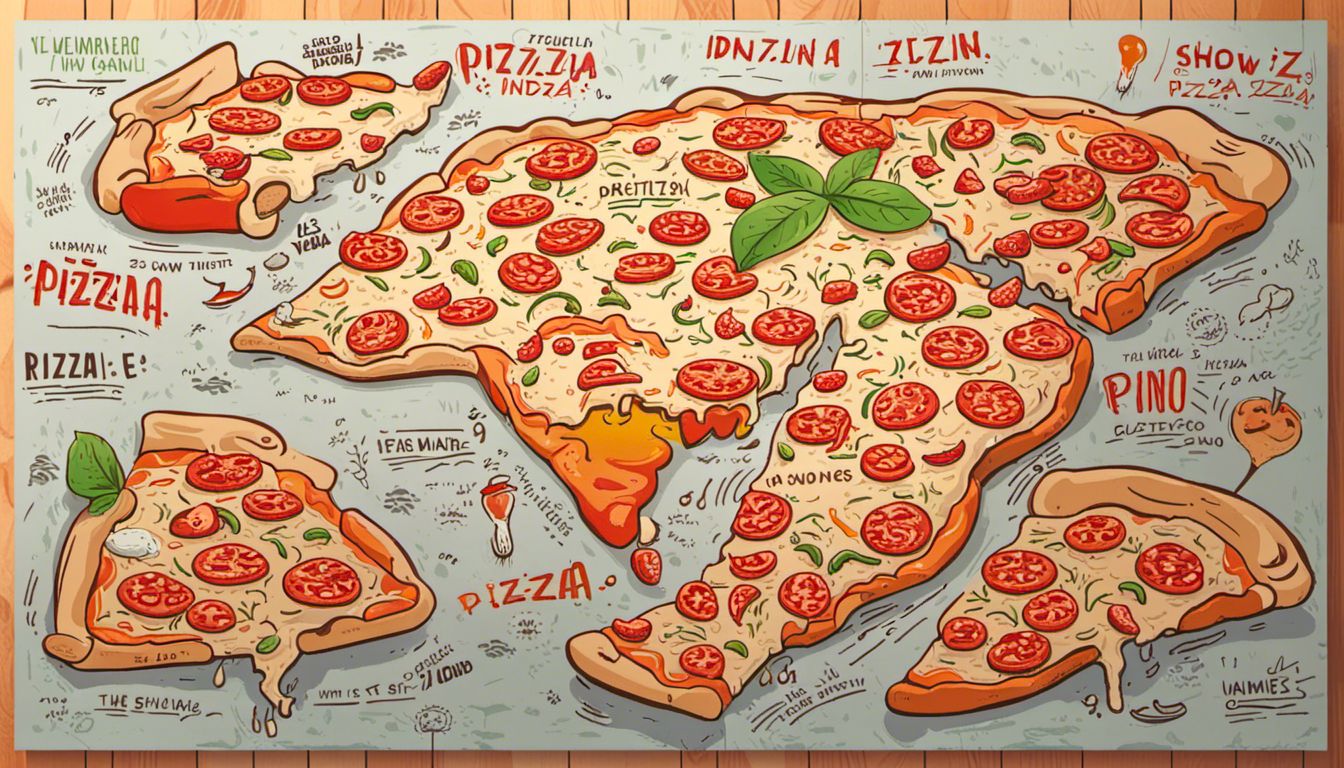
Aug 6, 2023
Can La Pino’z Build a 10,000 Cr Global QSR Brand from India?
Food
Brand
Bootstrapped
B2C
Profile
Last fortnight La Pino’z opened its 2nd store in the UK after explosively going international in 2022.
Shake it Till you Make It
Sanam Kapoor had a stable job at HCL.
He always intended to start something, which he shared with his father. Completely against general wisdom said in 2011, he left his stable job.
He started a small pizzeria and called it Pinocchio Pizza.
Sanam started with a single 120-square-foot store in the bustling market of Sector 9 in Chandigarh. Wanting to do something different in the industry, he began selling giant slices of pizza inspired by a similar trend in Western countries.
Despite having no formal training in the culinary arts or the food industry, Kapoor ventured out. Starting a pizza business in an industry worth 1,300 crore, dominated by a few international brands, hardly seemed logical.
At the time, Domino’s controlled the industry with a 54% market share, followed by Pizza Hut and Papa John's.
Pizza was a novelty when these brands first entered the market, served only at big five-star hotels. By 2011, they had managed to carve out a call for themselves, with delivery in under 30 minutes and new affordable small pizzas at 29 rupees becoming all the rage.
They were also growing at an astonishing rate. With a CAGR of 46%, Domino’s opened around 60 stores in 2010 alone, increasing to 410 stores in 96 cities by mid-2011.
But Kapoor saw an opportunity here: to create a pizza brand that was catered to the taste preferences of the Indian population. Pinocchio was rebranded.
"La Pino’z" literally means "Giant Pizza Slice" in Italian.
La Pino’z aimed to create an affluent brand, exuding the look and feel of an authentic Italian establishment.

He started alone with a small capital from his family. He did everything by himself, from branding, designing the stores, developing recipes and making the whole pizza from scratch with fresh ingredients.
He focused on creating a menu that combined the familiarity of Indian flavours with the novelty of the pizza. For this, they used indigenous vegetables for toppings.
In no time, people began to appreciate the taste and freshness of the pizza. With no marketing, La Pinoz started growing through word of mouth alone.
On a Franchise Roll
By 2012, Kapoor was taking a slow and steady approach to expanding his business.
He was struggling to go beyond one restaurant. He started with his first outlet in Chandigarh but faced numerous challenges.
He opened his second outlet in Mohali, where he faced a different set of challenges due to the diverse customer base. He learned to adapt to the market, adding new items to the menu based on customer feedback.
Kapoor's pizza business initially offered only giant pizza slices.
However, he quickly realised that he needed to diversify his offerings to cater to different customer preferences.
He added small round pizzas and later introduced medium and large sizes. He emphasised the importance of adapting to market needs and responding promptly to customer feedback.
After establishing his business, Kapoor started franchising in 2013.
However, the initial franchising attempts were unsuccessful due to various issues, including franchisees not adhering to the brand's quality standards and needing to report sales accurately.
Kapoor learned from these experiences and reevaluated his franchising model. He reduced the royalty rate and emphasised the importance of maintaining product quality and following ethical business practices.
La Pinoz crossed 50 outlets by 2015, scaling from just 1 in 2013.
The rationale for sticking to franchising was simple. It allowed a “physical” food brand to scale without the constraints of setting up stores.
The pioneer of franchising, McDonald’s leveraged franchising to achieve rapid expansion, tap into local market knowledge, reduce costs, boost brand loyalty, and foster continuous innovation.
Each store was franchised, usually by a local operator whose understanding of the nearby market is likely far superior to any national or mainstream player. Locals tended to understand better the target audience, areas, and native tastes and preferences.
Franchisees shared the financial risk and benefit from training and support, while localised marketing enhanced customer engagement. This scalable model attracted diverse talent, solidifying the brand.
Maintaining quality and process at scale was the real challenge, but it was successfully done. McDonald's did it in India through Westlife, Domino’s did it through Jubilant.
La Pinoz would do it in India, as it entered 2016 with momentum.
Too Many QSR Cooks Spoil the Broth
2016 seemed like a great year for QSR.
During this time, the food services industry was pegged at a market size of Rs. 3.1L crore was expected to grow at a CAGR of 10% over the next five years.
One of the fastest growing segments of this market was the quick service restaurants (QSR). It was expected to grow at a CAGR of over 22% from its base of Rs. 9,100 crore in 2016. Around one-third of this was attributable to the market size of pizza-focused restaurants alone.
QSRs had arrived on paper. However, the ground reality was different.
KFC’s outlets in India decreased from 395 in 2014 to 315 in 2016. Barista outlets were reduced by 35 from 2011 to 2016. Almost half of the QSRs then playing in India had negative EBITDA, and only 22% had margins of over 10%.
The reason was apparent.
Over 80% of the QSR chains were competition for the same consumers, concentrated in big metro cities. The vast opportunity described by the on-paper numbers had led to a fast expansion spree. The advent of food delivery apps amplified the options available to consumers.
The laws of supply and demand were disturbed in the food market and the commercial property space as rents in attractive streets skyrocketed.
The same story was playing out in the pizza space. The market was characterised dominance of the early entrants - Domino’s and Pizza Hut. Both utilised aggressive discount-fuelled marketing tactics in a value-obsessed Indian market.
Even multinational chains were suffering.
In 2015, Eagle Boys Pizza, an Australian brand, planned to increase its stores in India from 18 to 350. By 2017, it was left with only one store in Pune. South Africa’s Debonairs entered India twice before giving up.
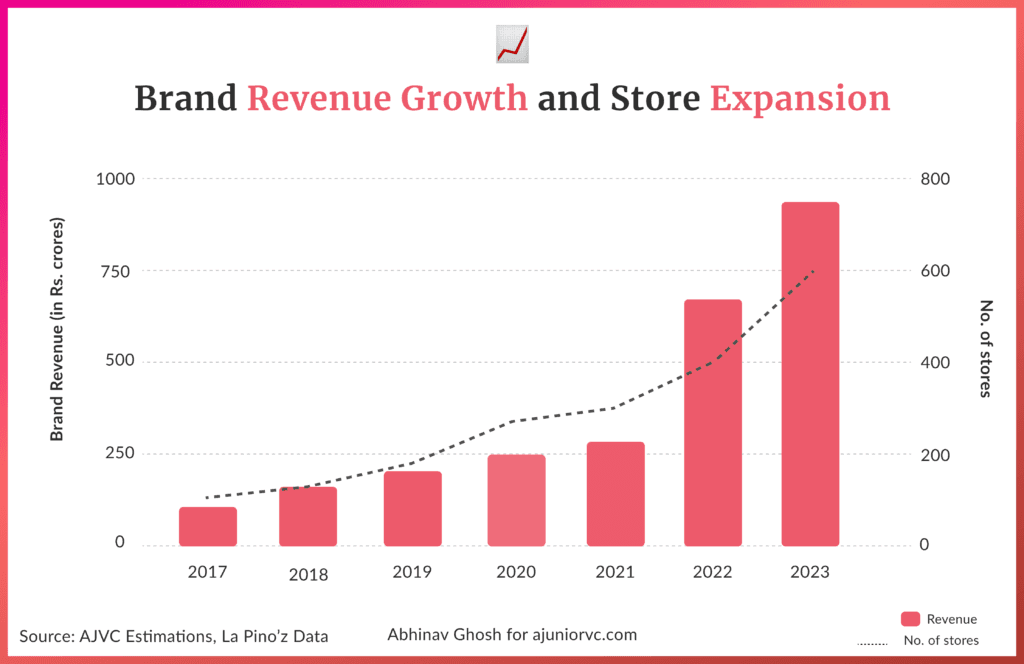
Sbarro’s master franchisee in north India initiated the shutdown of its stores during the same period.
Sanam navigated a problematic market by constantly adapting to customer feedback. Initially offering only a slice for around ~INR 80, La Pino’z added small, albeit entire, pizzas for INR 49 to match their competitors' value proposition.
Subsequently, medium and large-size pizzas were added, in line with industry standards set by its competitors.
Not only did La Pino’z adapt to market expectations when required, but they also differentiated themselves to stand out.
Its pizza base was thinner than its competitors, and its dough was freshly made multiple times daily.
Unlike Domino’s, where bases are transferred to outlets from central distribution centres. It allowed its franchisees to open exclusively vegetarian outlets based on local cultural practices.
Through these cycles of adaptions and differentiations, Sanam strove to retain the brand’s focus on quality offerings by regularly visiting franchisee stores.
On one of his visits, he noticed an outlet using a cheaper sauce, compromising the quality of the offerings. On another visit, he identified a franchisee owner selling products without billing to bring down their royalty payments.
The eagerness to adapt and respond to feedback extended to La Pino’z’s business model.
He renegotiated the terms with the offending owner, bringing down the royalty share from 8% of outlet revenues to 4%. Of this, La Pino’z would take 2%, and the local operator would take 2%.
The explosiveness had started to show.
Subway to 100 Store Heaven
By 2017, the La Pino’z brand had crossed 100 outlets nationwide.
By 2018, it was 150. As it entered 2019, La Pino’z took about six years to reach its first hundred outlets and just two to add the next hundred.
After the cautious start, extensive groundwork was laid while resolving teething troubles in the early days of the franchise model.
The painstaking effort meant that the business could now compound.
Kapoor’s meticulously gathered knowledge of the Indian customer’s desired flavour profile, an unwavering focus on product quality, financial prudence and value-for-money positioning developed La Pinoz’s core for its next leg of growth.
The conscious commitment to use fresh dough and produce without resorting to a centralised procurement model continued to affect unit economics compared to bigger QSR chains.
However, the lack of national-level marketing and lower rents owing to compact, delivery-oriented stores (~700 sq. ft.) partially offset the same. Likewise, the capex was tightly regulated, resulting in overall franchisee costs of ~Rs. 30 lakhs, with a payback period of under four years.
Steering clear of the master franchise model, which was the modus operandi of multinational QSRs, La Pino’z preferred local operators instead.
These operators' limited locus of control was quickly made up for by the high degree of hold and unique insights about the geographies they catered to. To Kapoor’s credit, Pinoz allowed the franchisees an unusual degree of autonomy at the cost of complete standardisation.
This was seen in the operator building for the local context.
Certain devout Indians are renowned for being equal parts food-loving and God-fearing. Their keenness to try new cuisines and exotic flavours was often restrained by an unconditional requirement that the cooking premises be meat-free.
Keenly aware of the community’s regional sentiments and unhampered by excessive SOPs typically imposed by large international QSR chains, many franchisees in Gujarat became home to ~30% of La Pinoz’s outlets. Gujarat’s La Pinoz was positioned and operated as a vegetarian-only brand.
Another example of Kapoor bucking the trend and betting against the consensus can be seen in how La Pino’z has spread its footprint.
Learning from the extreme competition in urban centres and metros, La Pinoz did what was strategically the right call.
In 2019 when there were 130 outlets, 80% were in metros and Tier 1 cities, in line with the industry norm. As it grew, the share of Tier 2 started to reach an appreciably healthy 42%, meaning the non-metro push was deliberate.
Over time, this decision bestowed La Pino’z with moat-like benefits as it went past the inflexion point of 150-200 outlets for local and regional QSR chains.
However, the variability in offering and positioning could hold it back as it scaled up. Winning in the QSR market needed one thing.
Scale.
QSR BOGO Mania
QSR chains accounted for Rs. 18,800 crores in FY20.
Despite the struggles of 2016, they kept going. QSR was the fastest-growing segment in the organised food services market, buoyed by favourable demographics, growing disposable incomes, changing lifestyles and increased convenience facilitated by food aggregators.
The broader industry witnessed a conscious rethink of store space and footprint to optimise the channel mix and maximise the average spend per customer.
QSRs were increasingly the preferred format, given the compact store sizes, tighter kitchen management practices, focus on store-level profitability and the proven success of Domino’s and McDonald’s.
Moreover, the rising share of takeaways and food delivery services meant that players found even more merit in rationalising real estate in their operations and focusing on digital capabilities.
Within the chain QSR segment, burgers and sandwiches accounted for a 31% revenue share, followed by pizzas and chicken at 26% and 15%, respectively.
While international brands continued to dominate the space, the peculiar preferences and palate of the average Indian meant that between a third and a fourth of the offerings by Domino’s, Subway, Pizza Hut, McDonald’s, Burger King, and KFC (‘the Big Six’) were exclusively India-specific.
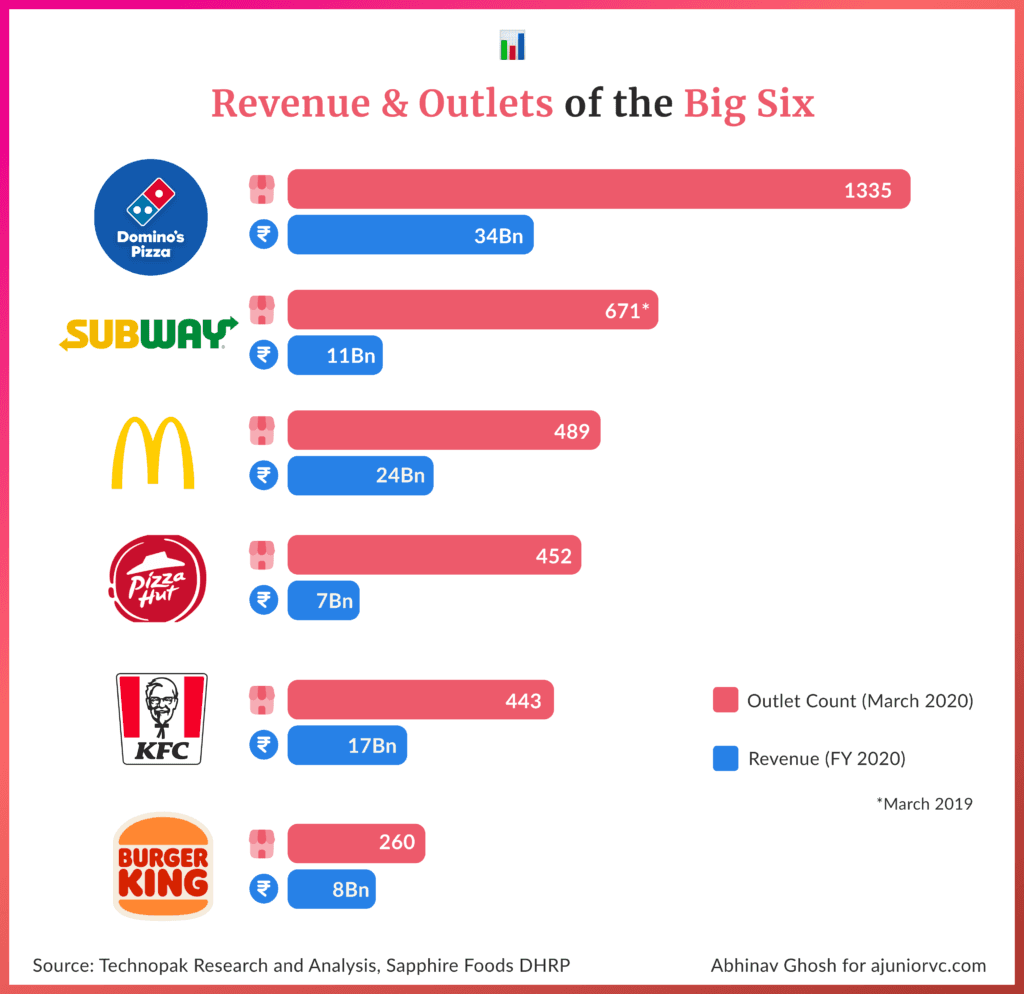
As such, the customisation was worth the effort and the spending, given that India's 15-24 age bracket had an affinity for QSRs.
The focus resulted in a higher average outlay and a general propensity to eat out or order in more frequently than their elders. Discounts and wise bundling further induced this through combos and value meals. QSR Chains counted on patrons having exposure to global food trends, familiarity with exotic cuisines and openness to newer formats.
This meant that between one-half to three-fourths of the stores of the Big Six were concentrated in the top eight metro cities. Specifically, India's chain pizza and chicken space was hyper-fragmented, enabling the Big Six to quickly corner a healthy market share.
The industry faced a chronic shortage of talented manpower, which meant that in-house training programmes acted as significant differentiators.
Moreover, significant property costs, disjoint supply chains and ominous compliance requirements would translate into sizable gestation, which, in turn, imposed a capital barrier to enter the market.
Scaling in this landscape was thus incredibly difficult. But La Pinoz was used to difficult.
Until 2020’s shock would have all players reimagine how they operated.
Slicing Through Challenges
In 2020, COVID-19 strikes and the nationwide lockdown immediately shut down all eateries, hitting the QSR industry hard.
Dine-in accounted for 75% of the industry's revenue and was virtually nonexistent. Even when restrictions eased, the fear of infection kept customers away.
The pandemic also disrupted the supply chains of these QSRs. Restrictions on transportation and a reduced workforce meant difficulties in sourcing ingredients and maintaining consistent quality.
In terms of employment, a report by the National Restaurant Association of India (NRAI) suggested that the restaurant industry, which employed 7.3 million people in India in 2019, saw a decline of about 40% in the workforce during the pandemic.
Before COVID-19, La Pino'z had a balanced business model, with dine-in and delivery making up 50% of their sales. However, as lockdowns ensued and dine-in options ceased, the balance tipped in favor of delivery.
Due to the lockdown, La Pino'z faced an existential crisis. Their physical stores were lying vacant, the delicious aroma of baking pizzas replaced by the chilling silence of lockdown.
The brand had to adapt, and it did so.
With determination and foresight, La Pino'z shifted its focus to delivery. The idea was simple: if people couldn't come to the pizzas, the pizzas would go to them.
La Pino'z's doubled down on their delivery service.
As the reality of the pandemic set in, the company quickly understood that home delivery would be the new norm. The brand shifted its strategy to prioritise delivery further, ensuring survival during these challenging times.
This strategic shift was successful, and even after the immediate impact of COVID-19 began to ease, the growth in delivery sales continued to stay strong.
This sustained growth can be attributed to customer convenience and promotional incentives offered through La Pino'z's app. Delivery boys in La Pino'z uniforms became a common sight, zooming through the empty streets. Online orders surged, and La Pino'z was back in business.
But challenges were never far behind.
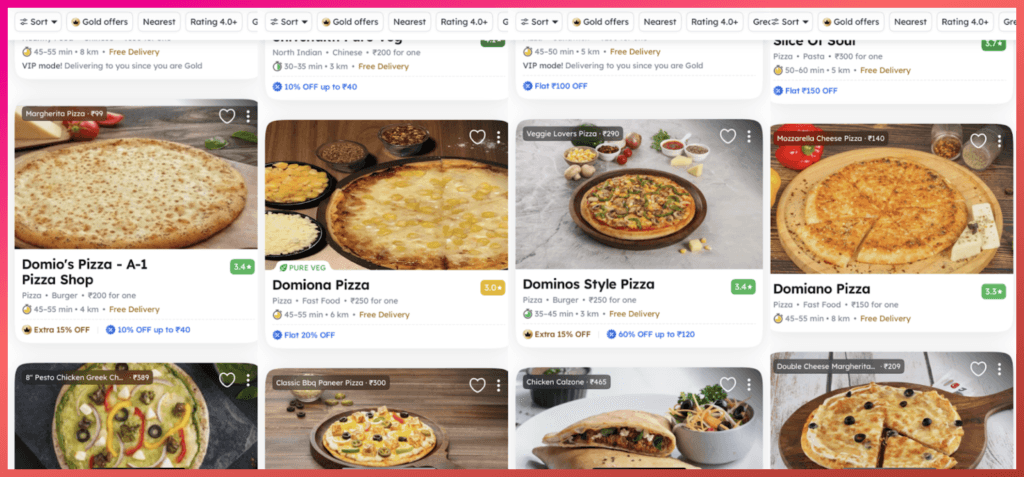
Local competitors quickly filled the void left by international giants. Local pizza places undercut La Pino'z and global chains with tantalising offers and lower prices. Most would name their stores after the large brands.
This was a battle for survival, and La Pino'z knew they had to play their cards right.
La Pino'z knew how to stand out from giant single slices to monster pizzas. Despite the trend shifting towards 'everyday value' offers, La Pino'z continued with its famous "Buy One Get One Free" (BOGO) offer. Sticking to their signature offer worked in their favour, attracting a loyal customer base.
Their vegetarian focus, strength in Tier 2, local flavours and word of mouth kept them going in real tough times.
By 2021, La Pinoz was back to its explosive growth as the landscape tottered.
Spreading the Dough
Where multiple MNCs shut shop, La Pino’z prevailed.
In FY22, Copenhagen Hospitality Private Limited, the holding company for the franchisee business earned profits of Rs. 27.8 crore on operational revenues of Rs. 109 crore.
The most significant revenue stream for the company, however, is not royalties. Almost 83 per cent, amounting to Rs. 91 crores of its revenues, were derived from selling raw materials to its franchise outlets. Outlets are contractually mandated to purchase certain types of ingredients from La Pino’z.
The company also earned Rs. 7.4 crore in royalties and Rs. 9.1 crore in franchise fees, cumulatively accounting for ~15% of its income. Franchise fees are the initial cost paid to La Pino’z by franchisees to set up their outlets and amount to Rs. 10 lahks.
The remaining 1.4 per cent was earned by rendering freight and marketing services for its franchisees.
However, its profits are skewed differently. The margins from selling ingredients to franchisees account for only 35 per cent of the company’s bottom line, with the remaining 65 per cent mainly emanating from franchise fees and royalties.
To understand what it means for La Pinoz, we must understand what it means for franchises.
In 2022, La Pino’z had 350 to 450 franchisee outlets in India. As such, La Pino’z earned royalties ranging from Rs. 1.6L to Rs. 2.2L per store. Each store pays a royalty of 4 per cent, equally distributed between La Pino’z and state-level local operators. This works out to a per-store revenue range of Rs. 80.2 lahks to Rs. 1 crore as of FY 22.
Purchasing input ingredients is the most significant expense on these revenues - accounting for almost 40 per cent of a restaurant’s revenue, leading to around 60 per cent gross profit margins. The second most crucial chunk of expenses is usually attributable to employee expenses, including delivery charges, accounting for another 20 per cent. Utilities, rental and maintenance expenses take away another ~15 per cent.
Royalties and applicable charges add up to another ~5 per cent, leading to EBITDA margins of ~20 per cent. After accommodating depreciation & taxes, the net profit margins for each store are usually around 10 per cent.
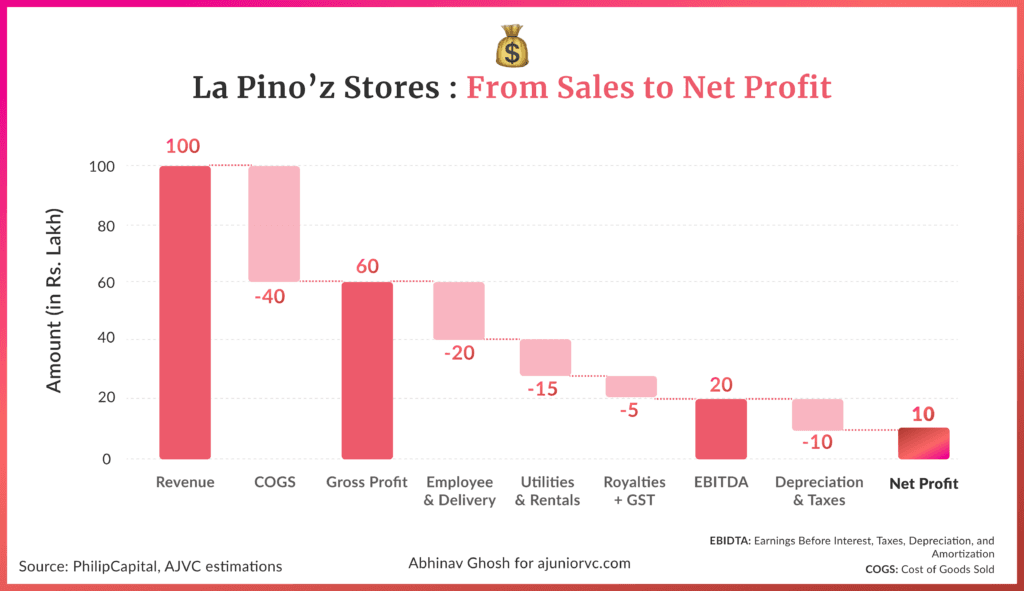
Each store requires capital expenditures of Rs. 50 - 60 lakh, inclusive of franchise fees. With sustained sales growth, each store can attain 4-year payback periods.
We can extrapolate the above numbers to arrive at La Pino’z brand revenues across all its stores in India.
Noting an increase in store numbers to 600 at the end of FY 23, and assuming a per-store revenue of Rs. 1.5 crore, with the increase attributable to inflation and sales growth, we can arrive at total brand revenues of approximately Rs. 900 crores across all of La Pino’z franchises in India as of FY 23.
La Pino’z Franchises have seen an astonishing growth of almost 10x in 6 years, incredible for an entirely homegrown brand.
La Pino’z had set sights outside the country.
Rising to the Top of the Food Chain
By 2022, La Pino'z had established a firm presence in India with over 500 outlets.
The question posed was, "What's next?"
Like any business, pizza chains constantly seek ways to expand their customer base and increase revenues.
One way to do this is by diversifying their offerings. Introducing new formats, such as burgers and cafes, allows pizza chains to cater to a broader range of customers and their varied food preferences.
New product introductions can keep current customers interested and coming back.
When a pizza chain such as La Pino’z ventures into new formats like burgers and cafes, it's often driven by a desire to increase its same-store growth rate, or SSGR.
By diversifying its offerings, La Pino’z can tap into new markets and consumer segments, potentially driving a higher steady-state growth rate over the long term.
Cafes and burgers are also popular and widely consumed food formats. By branching into these areas, La Pino’z tapping into established markets with high demand. This means they can potentially see a significant increase in their customer base and revenue.
Moreover, diversifying their offerings helps pizza chains mitigate risk.
If the pizza market faces a downturn, they have other product lines to fall back on. It's a business diversification strategy that spreads its risks across different food categories, reducing its vulnerability to fluctuations in a single market.
Another way to diversify is to go global and tap into established markets. La Pino'z has successfully launched its brand in the UK and UAE, becoming India's pioneering QSR pizza brand to reach the international market.
In 2023, La Pino’z launched a new venture called Lord Petrick, a high-end brand specialising in burgers and coffee. Kapoor has ambitious plans to expand Lord Petrick, with a target of opening 100 outlets across India by the end of 2023.
In addition to being known for La Pino'z Pizza, Kapoor's vision is to establish Lord Petrick as a leading brand in India, renowned for its large burgers and exceptional coffee.
The ultimate goal is to make a global mark with La Pino'z Pizza and Lord Petrick, setting new standards for premium pizzas, burgers, and coffee.
A dream seen in 2011 was now coming true.
Bursting Through the World
Born out of sheer determination, the brand, against all odds, achieved a staggering revenue of INR 1,000 Crore, purely on its own steam.
A completely bootstrapped venture, La Pino'z Pizza relied not on external investments but on the quality of its offerings, its strategic expansions, and the robustness of its business model. This remarkable feat is set against a highly competitive market dominated by international giants.
The potential for exponential growth is genuine with the management's audacious vision to open over 1,000 stores in the next two years. The favourable market scenario further supports this bullish sentiment.
The anticipated annual salary increases for white-collar workers beginning July 2023 should bolster the average disposable income. This would likely surge the demand for quick-service restaurants (QSR) like La Pino'z Pizza.
The expected increase in infrastructural spending before the central elections 2024 could lead to an overall improvement in macro liquidity, further fueling the QSR market.
However, amidst this rosy growth trajectory, the company is grappling with a few challenges that could hamper its momentum.
One of the critical issues pertains to the compromised quality of home-delivered pizzas. The reliance on delivery riders from various online food aggregators, coupled with lengthy delivery times of about 35-40 minutes, has reportedly resulted in a discrepancy between the quality of in-store pizzas and those delivered home.
The freshly prepared dough, a signature aspect of La Pino'z and a competitor differentiator seems to lose its charm when it reaches customers' doorsteps. To combat this, the management is investing heavily in enhancing the store ambience, encouraging customers to dine in and experience the pizzas in their best form.
Additionally, La Pino'z faces an issue of inconsistent store ratings due to individual franchisee management. This variability, often due to differing operational practices and varying degrees of customer service passion, has made standardisation across all stores challenging.
But as it opened its second UK store, it is impossible not to see what has been created entirely from scratch.
The story of La Pino'z Pizza is one of ambition, achievement, and aspiration. As it stands on the cusp of phenomenal growth, addressing these challenges could translate the company's ambitious vision into reality. As they say, no journey worth having comes without its share of obstacles.
This relentless aspiration shapes the ethos of La Pino'z Pizza – a brand that aims to succeed and set the benchmark in the Indian QSR industry.
It has fought competition, consensus and built quietly as the industry has gone through cycles. With its never-say-die spirit, La Pino'z is poised to turn the world of pizzas in India, one slice at a time.
As it sets its path to reaching 2,000 Cr of store revenue, it could be India’s first homegrown 10,000 Cr QSR export.
Writing: Nikhil, Parth, Samarth, Shreyas, Tanish and Aviral Design: Abhinav and Stable Diffusion